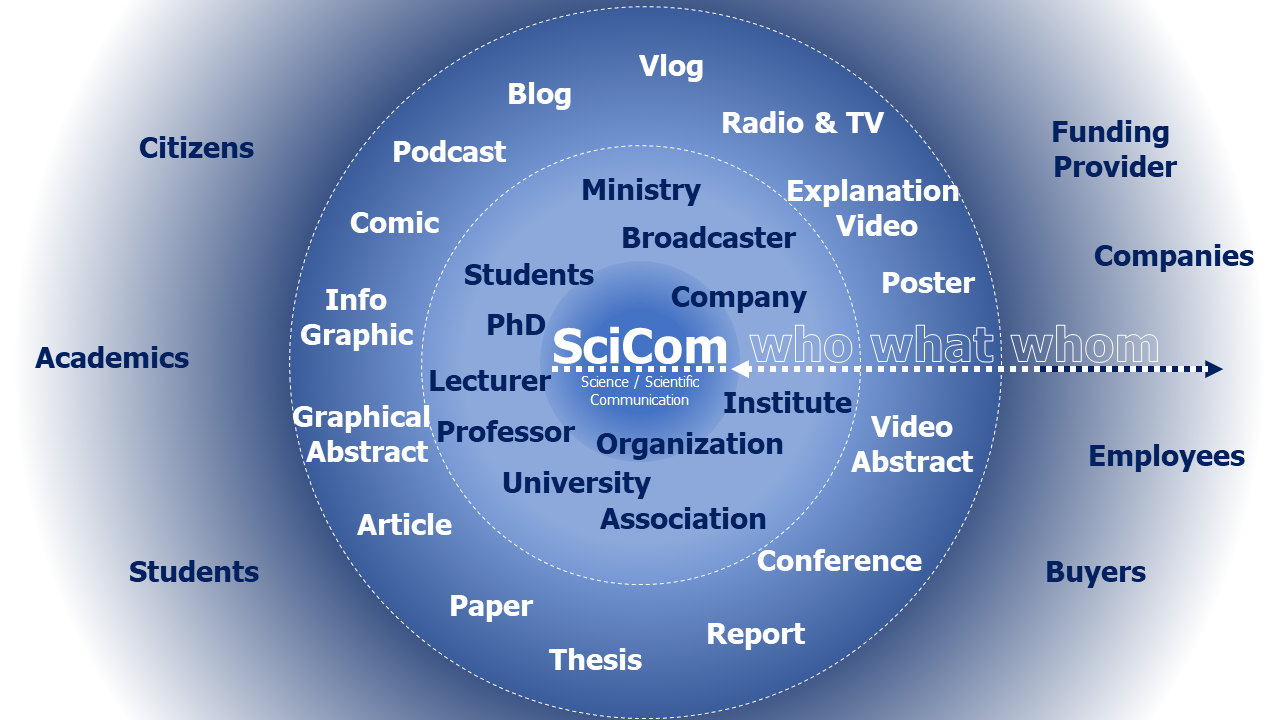
Science Communication
Science Accessible and in a Dialogue



Themen & Inhalt
- Why researchers communicate?
- Discussion with society
- Transparent resource use
- Intrinsic motivation
- Self-promotion
- Types of science communication
- Focus on your Audience = Avatar Persona
- How to create an avatar persona?
- Using templates?
- Avatar Persona Template 01
- Avatar Persona Template 02
- Story Telling
Why researchers communicate? ^
Science communication is the practice of researchers and institutions to disseminate scientific information, findings and insights beyond traditional journal publications, especially via social media and other platforms. It aims to reach both the scientific community and the general public and to promote understanding, dialogue, and engagement with scientific concepts and advances.
Discussion with society ^
Trust in science and the denial of scientific knowledge are topics of ongoing discussion in our current society. Even if in fact only a small part of the people actively question majority scientific opinions, there is a very aggressive community, especially in social media, characterized by false statements. Therefore, an important task is the dialogue and the ideology-free communication of scientific work and scientific findings not only in the interested expert community but especially for a broad audience, for the people. This motivation also shapes the content offered by the public TV and radio broadcasters: the communication of knowledge and scientific results.
Transparent resource use ^
Science needs public funding in order to gain knowledge independently and without direct economic success. However, the use of taxpayers' money must be presented in a transparent manner and the necessity and the results must be clearly shown to the citizens who pay the taxes. In most publicly funded research projects, it is therefore mandatory to report on the scientific work and its results. Not only at scientific conferences, but also in media that are accessible to everyone.
Intrinsic motivation ^
Researchers have a genuine interest in their fields of study. A significant part of every research process involves sharing findings and insights. While passion is a driving factor, effective communication strategies are vital for broad dissemination.
Self-promotion ^
Research entities often operate with external funding considerations and the need for skilled personnel. Additionally, young researchers aim to establish themselves in a competitive job market. Companies, too, communicate scientific affiliations and projects as a means to differentiate themselves from competitors. Science communication, in this context, is both a tool for knowledge dissemination and strategic positioning.

Types of science communication ^
more for the professional community:
- Scientific articles in journals and collective works.
- conference papers
for a broad population and non-experts
- Explainer videos & infographics for scientific results, research methods, academic writing, ...
- Vlogs about the daily life of academics
- Science (TV) Show
- Radio reports about the latest research results
- Podcasts with discussions between scientists, life and work of scientists, latest scientific findings, historical scientific results
- Blogs about life of academics, steps of a research work, latest scientific findings and conferences
Focus on your Audience = Avatar Persona ^
In software and product development, methods like "personas" (sometimes called "avatar") have been established for some time to make a user-oriented development. Also in other products and services putting yourself in the customers' shoes (in our case... of the podcasts listeners) is essential to be successful. The methodology of the avatar personas (as I call it) is to promote the greatest possible emapathy with the end customers & the audience. The persona (or several different personas) is the typical customer or listener. Since this persona has a realistic biography, realistic personal characteristics and thus represents a group of customers, I can empathize with them very well. I can "discuss" with this avatar persona all questions in the course of development and look at my product / podcast through its eyes. The avatar persona becomes my constant companion, my buddy, a familiar figure maybe something like a good friend (related to my product / my services / my podcast). It is easier to discuss my (initial and first) ideas with my avatar persona than to do this with all potential clients and listeners out there in the world (wide web).
![]()
![]()
How to create an avatar persona? ^
Basically, the avatar persona is a fictional but personalized representation of a target audience.
If we classify the totality of many persons, we form individual segments (e.g. profession, stage of life, special needs, ... ). This can also be called the target group. However, since a target group is still very heterogeneous and thus impersonal and rather imaginable on a theoretical level, one creates an avatar persona. This has personified characteristics and thus allows a good empathy and imagination of the needs and frustrations of the target group. However, it is not a concrete person from the target group, but a fictitious avatar composed of many characteristics of the target group.
![]()
Fictional and made up does not mean that an avatar persona is not based on data and facts. If this is not the case, it makes no sense for the product, the service or even for communication. The starting point for developing an avatar persona is therefore statistical data about the target group and personal interviews with people from the target group.
![]()
Using templates? ^
When searching for personas templates, many are found that seem to focus on demographic characteristics (age, gender, education, profession, hobbies, social media time,...). But... the usual list of data-driven properties must be adapted to the necessity of the task (product, service, communication). For example, if I want to develop a residential building with the help of an avatar persona, the way of living, the personal space requirements might play a bigger role than the time the person spends on social media. So it is always important to think critically about these data specifications and adapt them rather than just taking them over blankly!
![]()
The development of an avatar persona is primarily about its deep needs and goals as well about their paint points and frustrations. What my avatar persona want to accomplish and why my avatar persona want to accomplish it? Ask yourself what are the real goals? What forms the emotions? Don't stay on the surface, but explore the needs behind them. In addition to the needs and goals, it's about the pain points and frustrations. Describe their pain points and frustrations in as much detail as possible. Consider that different avatar personas have different pain points, even if they have the same needs and goals. It requires a detailed study in order to understand their frustration and their pain points.
Avatar Persona Template 01 ^
You are welcome to use this template.
Avatar Persona Template 02 ^
In the following template I have added another - from my point of view important - point. How can the pain points be improved by my product / service / podcast. How can I (or my product / service) help my persona, how can I make a difference and change.
Story Telling ^

Telling stories is a very complex task. The main thing is to create interest and to keep the listeners hooked to the story. An exciting story (also an interview) deals with one topic and tries to keep up the suspense.
The introduction and start to a podcast is especially important. If you are already very famous and have a large following, start with you personally: e.g. "Hello this is Christian Huber with another episode of my podcast". Please don't do this if only a few people actually know you, otherwise it seems more like embarrassing from my point of view. Better put the pain points at the beginning. Asking provocative questions without answering them right away can help to build up the necessary tension to keep listening. Maybe it helps if you speak from the point of view of your avatar persona. Personally, I don't make a big noise about my persona as a host, so I just briefly mention my name and go straight to my guests (if it's an interview) or my topic.
 Creative Commons 4.0 International Licence [CC BY 4.0]
|
Science Communication - Christian Huber
|
06.10.2023
|
Impressum
|
Datenschutz
Creative Commons 4.0 International Licence [CC BY 4.0]
|
Science Communication - Christian Huber
|
06.10.2023
|
Impressum
|
Datenschutz
This text was copyedited with the help of a generative pre-trained transformers / large language model
![Creative Commons 4.0 International Licence [CC BY 4.0]](https://melearning.online/WissenschaftlichesArbeiten/themes/simpletwo/images/meLearning/cc-by-large.png)